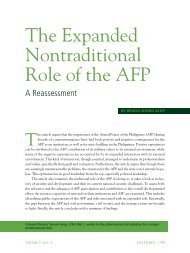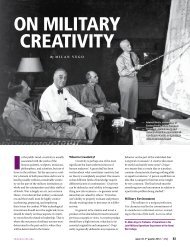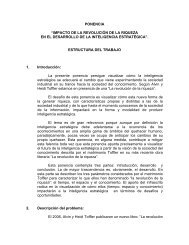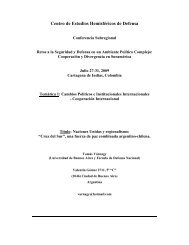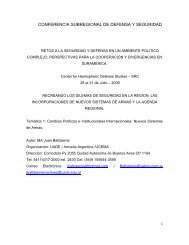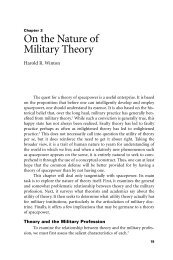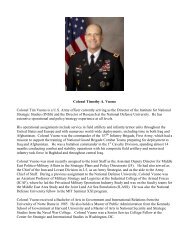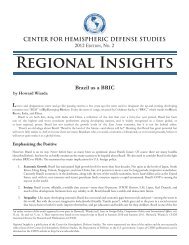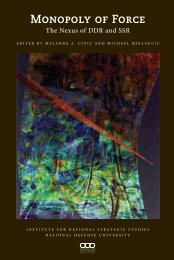In the second half of the 20th century, the US enjoyed pre-eminence ...
In the second half of the 20th century, the US enjoyed pre-eminence ...
In the second half of the 20th century, the US enjoyed pre-eminence ...
Create successful ePaper yourself
Turn your PDF publications into a flip-book with our unique Google optimized e-Paper software.
• Brainstorming (#2)<br />
• Conferences/Workshops (#4)<br />
• Expert Panels (#6)<br />
• Key/Critical Technologies (#28).<br />
The above methods are used toge<strong>the</strong>r with elements <strong>of</strong> Weak Signals/Wild Cards (#19), Trend<br />
Extrapolation/Impact Analysis (#25), or Roadmapping (#32) in varying degrees. Note <strong>the</strong>se are<br />
mostly qualitative methods that rely largely on individual judgment and expert intuition.<br />
There are numerous examples <strong>of</strong> such studies. We cite a report that examined <strong>the</strong> performance <strong>of</strong><br />
an earlier long-term TF for Army S&T 50 and <strong>the</strong>n made recommendations to improve <strong>the</strong><br />
approach by considering convergences between S&T areas and use <strong>of</strong> Roadmapping (#32) and<br />
Stakeholder Analysis (#33) TF methods. The assessment <strong>of</strong> <strong>the</strong> earlier 25–30-year long-term<br />
forecast—made 15 years later—showed that about one-quarter <strong>of</strong> <strong>the</strong> topics (5) were right on<br />
target, ano<strong>the</strong>r quarter (4) underestimated <strong>the</strong> subsequent pace <strong>of</strong> progress, and ano<strong>the</strong>r quarter<br />
(4) lagged <strong>the</strong> forecast progress. Three forecasted topics never substantially advanced at all, and<br />
<strong>the</strong> impacts <strong>of</strong> four rapid advances were missed related to <strong>the</strong> explosion <strong>of</strong> <strong>the</strong> <strong>In</strong>ternet, IT, and<br />
wireless communication applications in <strong>the</strong> late 1990s. One could argue that correctly identifying<br />
about three-fourths <strong>of</strong> <strong>the</strong> topics, incorrectly estimating <strong>the</strong> pace for one-<strong>half</strong> <strong>of</strong> <strong>the</strong> topics, and<br />
getting a few wrong by inclusion and a few by omission is fairly good and probably in <strong>the</strong> nature<br />
<strong>of</strong> such forecasts. It suggests that a revisit <strong>of</strong> any such long-term forecast every 5 years or so<br />
would be wise, but doing so more <strong>of</strong>ten may not be useful. Ra<strong>the</strong>r, techniques to track deviations<br />
from <strong>the</strong> forecast by comparison to regular technology data mining efforts might be wise, as<br />
discussed earlier.<br />
We also note <strong>the</strong> missed areas were all stimulated by developments outside DOD and were more<br />
in <strong>the</strong> nature <strong>of</strong> very rapid technology exploitation in <strong>the</strong> marketplace with unanticipated<br />
consequences for national security. As DOD becomes a smaller player in <strong>the</strong> global S&T<br />
enterprise, such missed forecasts are increasingly likely unless more robust TF methods are<br />
employed that involve broad-based participation <strong>of</strong> subject matter experts beyond DOD and <strong>the</strong><br />
United States and a means to independently and regularly monitor <strong>the</strong> evolution <strong>of</strong> <strong>the</strong> global<br />
S&T against this forecast. We note that <strong>the</strong> Delphi survey method (#27) originally developed by<br />
RAND in <strong>the</strong> 1960s 51 to mitigate issues <strong>of</strong> “groupthink” and <strong>of</strong> small number biases in expert<br />
panels is promising in <strong>the</strong> web-based context <strong>of</strong> today because it can readily scale to larger and<br />
more disperse participation. Moreover, broad survey participation stimulates <strong>the</strong> S&T awareness<br />
function <strong>of</strong> <strong>the</strong> participants. To <strong>the</strong> extent that individual expert opinion iterations in <strong>the</strong> Delphi<br />
method are also considered in a “weak signal” sense to target technical data mining activities, <strong>the</strong><br />
overall process can become more robust.<br />
50 Improving <strong>the</strong> Army’s Next Effort in Technology Forecasting, J.W. Lyons, R. Chait, and S. Erchov (ed.), NDU<br />
Defense & Technology Paper Number 73 (2010).<br />
51 See http://is.njit.edu/pubs/delphibook/.<br />
33



